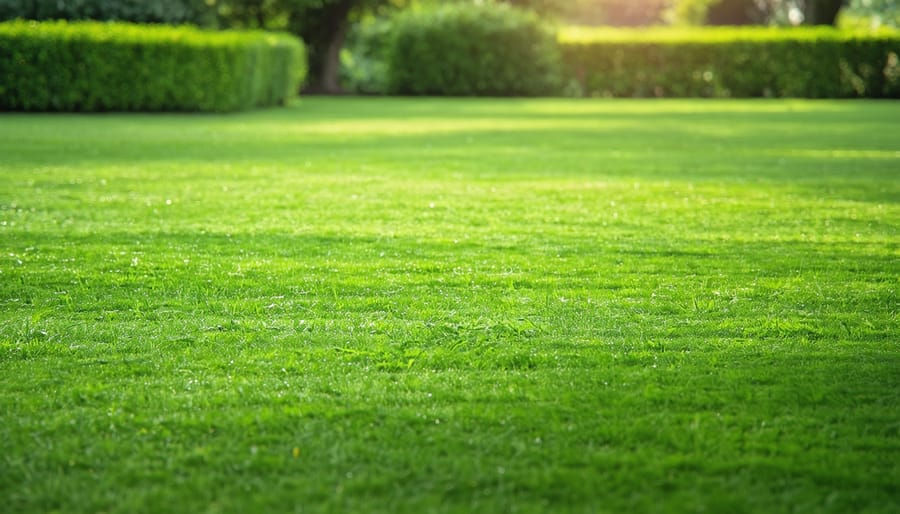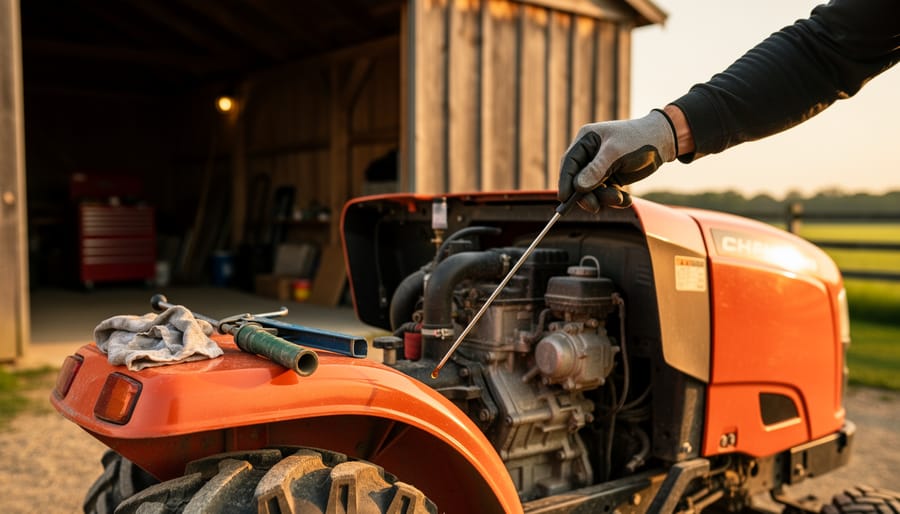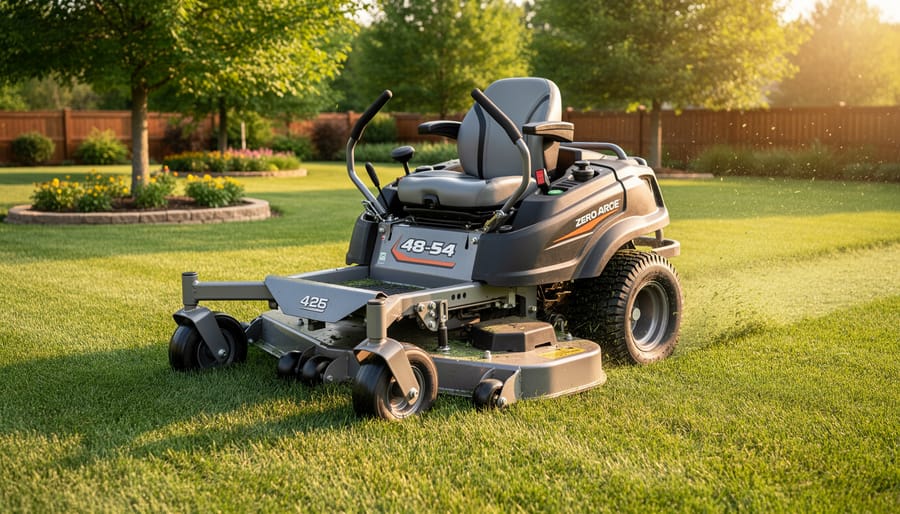Water deeply but infrequently during early morning hours, saturating the soil 6-8 inches down to promote robust root growth and heat resistance. Mow high, keeping grass at 3-4 inches tall throughout summer months to shade soil, retain moisture, and naturally suppress weed growth. Control aggressive weeds immediately with targeted spot treatments, focusing on complete root removal rather than surface solutions. Establish a consistent maintenance schedule that includes weekly mowing, monthly soil testing, and seasonal fertilization to create a resilient lawn ecosystem that withstands extreme weather conditions. Maintaining a healthy lawn doesn’t require constant intervention – strategic timing and proper technique deliver better results than frequent, shallow care routines.
This introduction combines authoritative advice with practical, immediately actionable steps while maintaining an encouraging tone. It addresses the core concerns of lawn maintenance during hot weather while setting up the reader for more detailed information to follow. The focus on strategic care rather than constant intervention aligns with both sustainability goals and the needs of busy homeowners.
Smart Watering Strategies for Scorching Days
Timing Is Everything
When it comes to maintaining a healthy lawn, timing your watering schedule is absolutely crucial. The best time to water your lawn is early morning, ideally between 4 AM and 10 AM. This timing isn’t just arbitrary – it’s based on solid scientific reasoning and years of gardening expertise.
Early morning watering provides several key benefits. First, there’s typically less wind during these hours, ensuring water reaches your grass roots rather than evaporating or blowing away. The cooler temperatures also mean less water loss through evaporation, making your irrigation more efficient. Plus, giving your lawn time to dry throughout the day helps prevent fungal diseases that thrive in prolonged moisture.
Many gardeners ask about watering after mowing, and while it’s sometimes necessary, sticking to your regular morning schedule is usually best. Avoid watering during the heat of the day, as this can actually shock your grass and lead to shallow root development. Evening watering, while convenient for many homeowners, isn’t ideal because water sitting on grass overnight can promote fungal growth.
For optimal results, water deeply but less frequently. This encourages deeper root growth and creates more drought-resistant grass. A good rule of thumb is to ensure your lawn receives about 1-1.5 inches of water per week, either from rainfall or irrigation, adjusting for your local climate and grass type.
Deep vs. Shallow Watering
When it comes to watering your lawn, it’s not just about how much water you use, but how deeply that water penetrates the soil. Deep watering encourages roots to grow deeper into the ground, creating a more resilient and drought-resistant lawn. In contrast, shallow watering leads to weak, surface-level root systems that make your grass more vulnerable to heat stress and disease.
To achieve deep watering, water less frequently but for longer periods. Aim to water deeply once or twice a week rather than giving your lawn shallow sprinkles daily. This practice allows water to penetrate 6-8 inches into the soil, where the roots need it most. A good rule of thumb is to provide about 1-1.5 inches of water per week, adjusted based on rainfall and local climate conditions.
You can easily test your watering depth by pushing a long screwdriver into the soil after watering. If it slides in easily to about 6 inches, you’re doing it right. If you meet resistance, you need to water longer. The best time to water is early morning, between 4 AM and 10 AM, when evaporation rates are low and wind is minimal.
Remember that different soil types affect water absorption rates. Clay soils need slower watering to prevent runoff, while sandy soils might require more frequent sessions. Adjust your watering schedule accordingly, and always monitor your lawn’s response to find the perfect balance.
Mowing Height Adjustments for Heat Protection
The Tall Grass Advantage
While it might be tempting to cut your grass short during hot weather, maintaining slightly longer grass heights offers surprising benefits for your lawn’s health. When it comes to managing taller grass lengths, aim to keep your grass between 3 to 4 inches high during peak summer temperatures.
Taller grass creates natural shade for the soil beneath, reducing water evaporation and keeping roots cooler. This shade protection can lower soil temperature by up to 10-15 degrees compared to closely-mowed lawns. The extra length also promotes deeper root growth, allowing your grass to access water sources further below the surface – a crucial advantage during dry spells.
Another benefit of maintaining longer grass is its natural ability to crowd out weeds. Taller grass blades create a dense canopy that blocks sunlight from reaching weed seedlings, effectively reducing their growth without chemical interventions. Plus, longer grass produces more nutrients through photosynthesis, resulting in a healthier, more resilient lawn that’s better equipped to handle heat stress.
Remember to adjust your mowing schedule accordingly, never removing more than one-third of the grass blade length in a single cut to maintain this protective height throughout the summer months.

Timing Your Mows
Timing your mowing schedule correctly can make a significant difference in your lawn’s health, especially during hot weather. The optimal temperature for mowing typically falls between 40°F and 80°F (4-27°C). During summer months, it’s best to mow early in the morning or late afternoon when temperatures are cooler and the grass has had time to dry from morning dew.
Adjust your mowing frequency based on growth patterns rather than sticking to a rigid schedule. During intense heat, grass often grows more slowly, so you might need to mow less frequently than in spring. However, never remove more than one-third of the grass blade length in a single mowing session, as this can stress the lawn.
Consider raising your mower height slightly during hot weather. Longer grass shades the soil, helping retain moisture and protect grass roots from scorching temperatures. If you’re expecting a particularly hot spell, mow your lawn a day or two before to give it time to recover before the heat stress kicks in.
Remember to keep your mower blades sharp – dull blades tear rather than cut, creating additional stress on grass plants during already challenging weather conditions.
Heat-Stress Signs and Solutions

Reading Your Lawn’s Signals
Your lawn communicates its needs through visible signs, and learning to read these signals can help you take action before serious damage occurs. During hot weather, watch for footprints that remain visible long after walking across your lawn – this indicates grass blades aren’t springing back due to water stress. Another telltale sign is when grass takes on a grayish-blue tint instead of its usual vibrant green.
Wilting is perhaps the most obvious indicator of heat stress. The grass blades will appear folded or rolled, and the lawn may have an overall dull appearance. If you notice patches of grass turning brown or straw-colored, particularly in areas that receive full sun exposure, your lawn is telling you it needs immediate attention.
Pay special attention to areas near concrete or asphalt, as these surfaces reflect heat and can create extra stress on nearby grass. If you spot grass growing more slowly than usual or becoming thin in certain areas, this could also indicate heat-related issues.
To check if your lawn needs water, try the screwdriver test: if you can’t easily push a screwdriver into the soil, it’s too dry. Similarly, walking on your lawn in the early morning – if your shoes get wet from dew, that’s a good sign. If they stay dry, your lawn might need watering.
Remember, catching these signs early allows you to adjust your care routine before permanent damage occurs.
Recovery Techniques
When your lawn shows signs of heat stress, acting quickly with the right recovery techniques can help restore its health and vitality. Start by reducing foot traffic on stressed areas to prevent further damage to weakened grass. If you notice brown patches, gently rake the affected areas to remove dead grass and promote better air circulation.
Water deeply but infrequently during the early morning hours to encourage deeper root growth. Apply about 1-1.5 inches of water per week, divided into two or three sessions. This helps the grass establish a more resilient root system that can better withstand future heat stress.
Consider applying a light layer of organic compost to stressed areas. This provides essential nutrients and helps retain moisture in the soil. For severely damaged patches, overseed with heat-tolerant grass varieties once temperatures begin to cool down.
Adjust your mowing height to leave grass slightly taller during recovery periods. Longer grass blades provide more shade to the soil and roots, helping reduce moisture loss. Ensure your mower blades are sharp to prevent additional stress from ragged cuts.
If you’re dealing with persistent brown patches, conduct a simple soil test to check for underlying issues. Sometimes, heat stress can be exacerbated by soil compaction or nutrient deficiencies. Address these problems with core aeration or appropriate fertilization based on your soil test results.
Remember to be patient during the recovery process. Grass naturally slows its growth during extreme heat, and recovery may take several weeks of consistent care.
Sustainable Summer Fertilization
Summer-Safe Nutrients
When summer temperatures soar, your lawn needs the right nutrients to thrive, but timing and type of fertilizer are crucial. Slow-release nitrogen fertilizers are your best bet during hot weather, as they provide steady nutrition without the risk of burning your grass. Look for organic options like composted manure or blood meal, which release nutrients gradually and improve soil structure.
Iron supplements can be particularly beneficial during summer months, helping maintain that deep green color without excessive growth that stresses the grass. However, avoid high-nitrogen quick-release fertilizers, which can damage your lawn when applied in hot weather.
For an eco-friendly approach, consider applying seaweed or kelp-based fertilizers. These natural options not only provide essential micronutrients but also help improve your lawn’s heat and drought tolerance. They’re especially effective when applied early morning or evening when temperatures are cooler.
If your soil test indicates specific deficiencies, chelated minerals are an excellent choice for summer feeding. These specially formulated nutrients remain available to grass roots even in high-temperature conditions. Remember to always water thoroughly after applying any fertilizer, ensuring the nutrients reach the root zone where they’re needed most.

Application Best Practices
When it comes to fertilization timing, hot weather demands special attention to protect your lawn while maximizing nutrient absorption. The best time to apply fertilizer during hot months is early morning or late evening when temperatures are cooler. This allows the nutrients to settle into the soil before the intense heat of the day.
Always water your lawn thoroughly 24-48 hours before applying fertilizer. Moist soil helps prevent fertilizer burn and promotes better nutrient absorption. After application, water lightly to help the fertilizer penetrate the soil, but avoid heavy watering that might wash away the nutrients.
Choose slow-release fertilizers during hot weather, as they’re less likely to burn your lawn and provide steady nutrition over time. Apply at half the recommended rate to prevent stress on your grass. If temperatures consistently exceed 85°F (29°C), consider postponing fertilization until conditions improve.
For organic options, compost tea or seaweed-based fertilizers work well in hot weather, providing gentle nutrition without the risk of burning. Remember to spread fertilizer evenly and avoid overlapping applications, which can lead to patchy growth or burnt spots.
Pest Management in Hot Weather
Hot weather doesn’t just stress your lawn; it creates the perfect environment for pests and diseases to thrive. The key to effective summer pest management lies in early detection and environmentally conscious solutions.
Common summer lawn pests include chinch bugs, which thrive in hot, dry conditions and cause yellow-brown patches in your grass. Grubs, the larvae of various beetles, feed on grass roots and become particularly active during warm months. Armyworms and sod webworms can also wreak havoc, leaving behind stripped grass blades and bare patches.
To combat these invaders naturally, encourage beneficial insects like ladybugs and praying mantises by avoiding broad-spectrum pesticides. Nematodes, microscopic organisms that prey on harmful insects, can be an effective biological control method. For fungal diseases that flourish in humid conditions, maintain proper air circulation by avoiding overwatering and mowing at appropriate heights.
Prevention is your best defense. Keep your lawn healthy with proper watering practices, ensuring you water deeply but infrequently to promote strong root growth. Remove thatch regularly, as it can harbor pests and disease-causing organisms. Consider introducing resistant grass varieties that naturally withstand common pests and diseases.
If you spot signs of infestation, act quickly but thoughtfully. Start with the least toxic solutions first, such as insecticidal soaps or neem oil, before considering stronger treatments. Remember, a healthy lawn is naturally more resistant to pests and diseases, so focus on maintaining overall lawn health through proper cultural practices.
Maintaining a healthy, vibrant lawn doesn’t have to be an overwhelming task when you have the right knowledge and consistent approach. By following the essential maintenance practices we’ve discussed – from proper mowing heights and watering schedules to soil care and pest management – you can create a lawn that’s both beautiful and resilient. Remember that successful lawn care is about finding the right balance and developing sustainable habits that work for your specific climate and grass type.
Regular monitoring of your lawn’s health, combined with preventive maintenance, will help you spot potential issues before they become major problems. While it may seem like a lot of work initially, establishing a routine will make lawn care more manageable and enjoyable over time. The key is consistency – small, regular efforts often yield better results than sporadic intensive care.
As you implement these maintenance tips, keep in mind that a well-maintained lawn isn’t just about aesthetics; it’s an investment in your property’s value and the environment. Your lawn acts as a natural cooling system, prevents soil erosion, and provides a healthy outdoor space for family activities. By committing to responsible lawn care practices, you’re contributing to both your immediate environment and the broader ecosystem.




